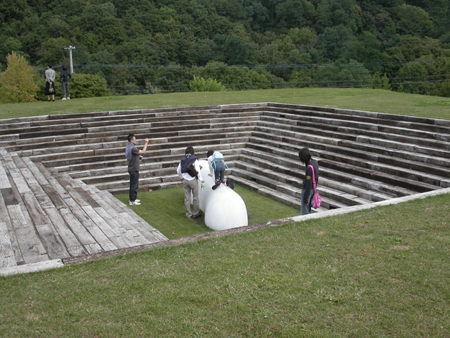ARTE PIAZZA BIBAI
Kan Yasuda was born in 1945 in the city of Bibai, on Japan’s northern Island Hokkaido. He spend his high school and collage years in Hokkaido. During his boyhood he was an enthusiastic high school baseball player. With the age of 24, Kan Yasuda graduated from the Sculpture Department, Graduate School of Tokyo National University of Fine Arts and Music, in 1969. In the following year, 1970, he came to Italy on a scholarship from the Italian government. He enrolled in Rome Academy of Fine Arts. There he sudied under the sculpture Professor Pericle Fazzini (1913-1987). Afterwards he set up his atelier at Pietrasanta in nordthern Italy, 80 km from Florence, near Carrara, the Italian marble-producing district. For the two millennium since the Romans discovered marble there, Carrara has produced the world’s finest marble. Already Michelangelo carved his masterpieces from its stone. Kan Yasuda was enchanted by the smooth touch of the white marble, and it reminded Yasuda of the snow in his hometown, Bibai. He was falled in love to this very hard, but also smooth shining white stone.
Kan Yasuda had exhibitions all over the world, his sculptures were shown in Italy, France, England and Japan. In Sapporo city you can find his sculpture at the Central Station Entrance, in front of Kitara and Hokkaido Museum of Modern Art.
Shift decide to look at Kan Yasuda’s sculpture park, called Arte Piazza in Bibai. So, on Sunday morning, 25th of September, I took the train to Bibai, it takes about half an hour. At the central station Bibai you have to change to bus. Then after quarter an hour you will stay at the entrance of the art place. It was a sunny day, perfect to look at an outdoor art place. I enter the area and the first I saw was a white marble block in the middle of the grass green meadow. I go closer to the cube and I saw that the block, sink with one edge into the earth, an other one rise into the heaven. The surface was very raw unpolished. There were other sculptures which have a more smooth surface, so smooth you will like to touch it.
In generally Kan Yasuda’s sculptures are not for a white artificial room in a museum, where you should not touch the art. His art is for the nature and for the people, kids, younger and older, you should play on it, touch it, to feel the deep voice of the stone. The white marble lost its laziness, as he would light fly over the ground. On the opposite the bronze artwork looked to me like it would be one with the dark brown earth.
I go to this park without any knowledge about Kan Yasuda. But his sculptures had a deep intense on my mind. Later I read a text about Kan Yasuda. I realized that his hometown, Bibai had a very dark past. While the second world war a lot of Chinese and Korean people were working in the local coal mines, at this time the mines were called death camps. Scores of workers pershed every day from malnutrition, starvation and violence mated out to prevent their escape. Also after the war, many people lost their life in the deep underground of the coal mine. “If only I could bring air to all those souls resting underground”, says Kan Yasuda while the place was under construction.
I think this is an important background to understand Kan Yasuda’s work at the Arte Piazza. Then one of his main theme in his work is about “life and death”. When you know about the history of the city you will look with different eyes to Yasuda’s work. Most all of his sculptures are connected with the earth, or stand out of the earth gasp for breath, like all the workers in the darkness of the coal mine gasp for breath and light.
Read more ...








